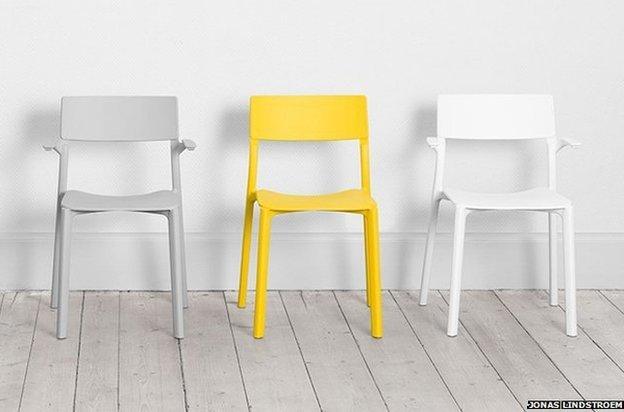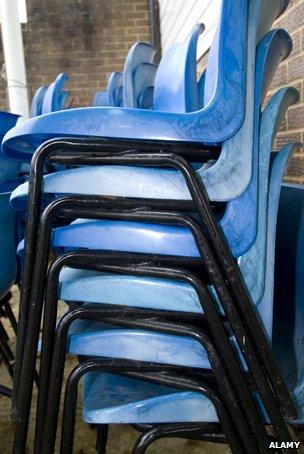Can anyone reinvent the everyday chair?
- Published

Wing chair, Chippendale chair (Alamy), Thonet No 14, Jasper Morrison folding Air Chair, Robin Day Polyprop chair (courtesy of the Design Museum, London)
Ikea is promising to "democratise" the furniture market by producing a mass-selling chair for use both in the home and public places. But can anyone surpass the giants of the everyday chair?
It's more than likely you've sat on a Polyprop chair. With its simple plastic shell, sitting on tubular steel legs, Robin Day's design is a classic of the church hall. And the school room. And the hospital. And the community centre.
It's cheap. It's easy to clean. Perhaps most of all, it's easy to stack.
And with millions sold, its place in the pantheon of "everyday" chairs is assured.
Ikea is making an attempt to join this pantheon. The world's biggest furniture retailer commissioned a Swedish company to create a chair which it says is equally usable in the home and in public places. The Janinge is being sold in its Swedish stores and is set for release in the rest of the world in February.
"The idea behind the Janinge collection is the democratisation of design, to create a strong, durable chair, based on the needs of both domestic and public environments," says Asa Hederberg, product developer at Ikea. "My aim was to create an attractive and commercial product at a low price."
The Janinges, which come in white, grey and yellow, were tested to industry standards for chairs designed for public places. They are intended to dominate two separate markets, but Ikea has some tough acts to follow if it is to compete with the most influential designs in seating history.

The Janinge, Ikea's much vaunted new model
The Thonet Chair Number 14, also known as the Bistro Chair, is believed to be the all-time bestseller, 50 million units having been made since its invention in 1859.
German joiner Michael Thonet created it using steaming techniques to bend wood. Its sensually rounded back gained the attention of Vienna's fashionable society.
Sold unassembled, its six parts simply had to be screwed together. A predecessor of flat-pack kits sold by Ikea, the Bistro Chair is credited with moving furniture from the handmade to the industrial age. Thirty-six Number 14s could fit in a crate of one cubic metre, making them easy to transport.
"They were designed for the residential market," says Thonet's managing director Thorsten Muck, "but it was also very successful in the larger contract market. A square piece of furniture tries to send a signal, but a rounded one is not like that. It shows modesty and warmth."

The Thonet 14 caught on across Europe, the US and Africa. Pablo Picasso and Albert Einstein were among the famous purchasers and several of the chairs featured in a Liza Minnelli dance scene in the film Cabaret.
The Janinge's main modern competition for innovation came from the UK. In 1963, Robin Day developed the polypropylene stacking chair, known as the Polyprop or Robin Day.
Day realised polypropylene, external, a plastic invented in 1954, would make a good seat shell, as it was tough, slightly flexible and light. It was mounted on legs made of high-tensile tubular steel. The company he worked for, Hille, invested £6,000 in a moulding tool which could turn out 4,000 a day.
Variants of this design abound around the world. In 1972 Hille launched the Series E range for schools - in five sizes and with a hole in the back to make picking them up easier.
Hille has sold 14 million Polyprops, entering functional settings such as prisons, schools, waiting rooms and hospitals where a Thonet 14 might look out of place. The number of near-replicas, with slightly different designs used to avoid problems with patents, is unknown.
Hille's sales manager, Nigel Punshon, claims he is not worried about the newcomer. "The Janinge will compete with a lot of chairs, but not really with ours," he says. "Ours are predominantly sold for public use, rather than the home.
"We don't just test to industry standards; we also test them by throwing them around and jumping on them. We really smash them about to get a sense of how they hold up under such treatment by children, patients and inmates."

In the 1960s the Italian designer Vico Magistretti designed the Selene, a "Monobloc" (one-piece) plastic seat. Its cheaply produced descendants are used mainly in outdoor spaces such as gardens. Usually plain white, they don't inspire much affection, but one blogger is attempting to collect pictures of Monoblocs, external from every country of the world, managing more than 80 so far.
The Janinge, also moulded in one piece, from 75% polypropylene and 25% glass fibre, is available in two models - one with arms, one without - and can be stacked, making it useable at large events.
The furniture industry is getting excited, with the Fast Co Design blog describing it as Ikea's attempt to design the "perfect all-purpose chair", external, with an emphasis on aesthetics essential to home use. The Decordots site, external calls it "beautiful".
"We're happy with the product," says Jonas Pettersson, founder of Form Us With Love, external, the Stockholm company that designed it. "I went to an Ikea store the other day with my family and talked to the staff about it. They didn't know I was one of the designers. They recommended the Janinge to me as a customer and it was really good to hear the way they talked."
The Just Stand group, external, which campaigns for less sedentary lifestyles, suggests the global average time a person spends sitting each day is 7.7 hours. With the world's population having passed seven billion, demand for affordable chairs is unlikely to dwindle.

How the chair became a staple

Until the mid-19th Century, most chairs were made by hand, but modern manufacturing techniques precipitated the mass production of cheaper furniture
Michael Thonet pioneered a new method of furniture-making using steam to bend solid beech for chair backs, creating the famous Thonet No. 14 chair in 1859
After World War One, cheaper materials became more available, meaning chairs could be made out of laminated plywood, tubular steel and plastic
In the 1960s, Robin Day used injection-moulded polypropylene and tubular steel to create his "polyprop" chairs, in a mould, making them light, strong, cheap and easy to stack

Ikea, which has 315 stores in 27 countries, wants to sell lots of Janinges. The look of the Janinge is simple, based on designs seen in Nordic timber frames. "We asked how we could construct a chair that's both appealing and robust and durable?" says Pettersson. "You find those things in the Bistro chair. But I think Scandinavian design is something that also has an appeal."
The Janinge, its name an amalgamation of the Swedish names Jan and Inge, is entering a highly competitive sector.
"In terms of functionality the chair's kind of been resolved," says Alex Newson, senior curator at London's Design Museum. "The Janinge's a lovely, affordable multi-use chair, but I don't find it's going to change chair design in the sense that it's going to do different things.
"You are going to have to come up with quite a chair to change things as much as the polypropylene stacking chair did. There's not a lot you can add to a standard everyday chair. You still have to have a back rest."

More from the Magazine

Furniture is often overlooked as a mundane feature of the home, but author Ian Sansom finds hidden meanings in cupboards, wardrobes and tables.
A number of studies have suggested that constantly sitting at work is bad for you. Could workplaces be rejigged around standing up, asks Chris Bowlby.

Subscribe to the BBC News Magazine's email newsletter to get articles sent to your inbox.